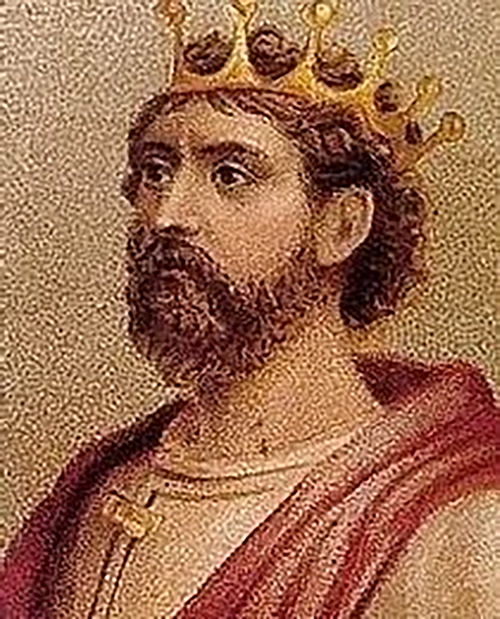



King Edmund 1st Ė Quick Stats





King Edmund I of England : The Warrior King Who Reclaimed the Danelaw
King Edmund I, also known as Edmund the Elder, was the King of the English from 939 AD to 946 AD. A member of the House of Wessex, he was the son of King Edward the Elder and Queen Eadgifu of Kent, and the grandson of Alfred the Great. Edmundís reign was marked by internal strife, military campaigns, and efforts to consolidate the kingdom in the aftermath of the Viking invasions. Despite his relatively short reign, Edmund played a significant role in restoring stability to England and laying the groundwork for future kings, particularly his brother Eadred and his sons, Eadwig and Edgar the Peaceful.
This article explores Edmundís life, his rise to the throne, the key events of his reign, and his legacy in English history.
This article explores Edmundís life, his rise to the throne, the key events of his reign, and his legacy in English history.
Background and Early Life
Edmund was born in 921 AD, likely in Wessex, during the reign of his father, King Edward the Elder. He grew up in a time when England was divided between Anglo-Saxon rulers and Viking settlers. The southern regions, including Wessex and Mercia, were under the control of Anglo-Saxon kings, while the northern territories, such as Northumbria, were dominated by the Danes.
Edmund was born in 921 AD, likely in Wessex, during the reign of his father, King Edward the Elder. He grew up in a time when England was divided between Anglo-Saxon rulers and Viking settlers. The southern regions, including Wessex and Mercia, were under the control of Anglo-Saxon kings, while the northern territories, such as Northumbria, were dominated by the Danes.
Edmund was the half-brother of King Athelstan, the first king to unify much of England. Athelstan was a towering figure in Anglo-Saxon history, and his achievements greatly influenced Edmundís early years. As a young prince, Edmund accompanied Athelstan on military campaigns, gaining firsthand experience in warfare and governance.
Born: 921 AD
Died: 26 May 946 AD (Pucklechurch, Gloucestershire, England)
Mother: Eadgifu of Kent
Father: Edward the Elder
Wife: ∆lfgifu of Shaftesbury
Children:
Eadwig (Edwy)
Edgar the Peaceful
Predecessor: Athelstan (Half-Brother)
Successor: Eadred (Brother)
Died: 26 May 946 AD (Pucklechurch, Gloucestershire, England)
Mother: Eadgifu of Kent
Father: Edward the Elder
Wife: ∆lfgifu of Shaftesbury
Children:
Eadwig (Edwy)
Edgar the Peaceful
Predecessor: Athelstan (Half-Brother)
Successor: Eadred (Brother)
The Reign of King Edmund I (939-946 AD)
Edmund became king in October 939 AD, following the death of his half-brother King Athelstan. His ascension to the throne came at a time of considerable turmoil. Athelstan's death created a power vacuum, and the Danes in northern England saw an opportunity to challenge Anglo-Saxon dominance.
Edmund became king in October 939 AD, following the death of his half-brother King Athelstan. His ascension to the throne came at a time of considerable turmoil. Athelstan's death created a power vacuum, and the Danes in northern England saw an opportunity to challenge Anglo-Saxon dominance.
Challenges from Viking Leaders
Almost immediately after Edmundís coronation, Viking leaders in Northumbria and the eastern Midlands rose in rebellion. The chief threat came from Olaf Guthfrithson, a Norse-Gael king from Dublin. Olaf seized York (Jorvik) and launched raids into southern England.
Almost immediately after Edmundís coronation, Viking leaders in Northumbria and the eastern Midlands rose in rebellion. The chief threat came from Olaf Guthfrithson, a Norse-Gael king from Dublin. Olaf seized York (Jorvik) and launched raids into southern England.
Edmund initially faced difficulties in repelling the Viking forces. Olaf's raids threatened the stability of the kingdom, and Edmund had to negotiate a treaty with him. In 939 AD, the Treaty of Leicester was signed, temporarily dividing the kingdom. Under this agreement, Olaf retained control of Northumbria and parts of the Midlands, while Edmund retained the rest of England.
However, Olaf Guthfrithson died in 941 AD, and his successor, Olaf Sihtricson, proved to be less capable. Sensing an opportunity, Edmund launched a military campaign to reclaim the lost territories.
The Reconquest of Northern England (942 AD)
In 942 AD, Edmund achieved a significant victory by reclaiming the Five Boroughs of the DanelawóDerby, Leicester, Lincoln, Nottingham, and Stamford. These towns were key Viking strongholds in the Midlands, and their recovery was a major triumph for Edmund. The Anglo-Saxon Chronicle commemorated this victory with the following verse:
In 942 AD, Edmund achieved a significant victory by reclaiming the Five Boroughs of the DanelawóDerby, Leicester, Lincoln, Nottingham, and Stamford. These towns were key Viking strongholds in the Midlands, and their recovery was a major triumph for Edmund. The Anglo-Saxon Chronicle commemorated this victory with the following verse:
"King Edmund, lord of warriors, protector of men,
reclaimed the Five Boroughs from heathen hands,
restoring them to Christian law and order."
reclaimed the Five Boroughs from heathen hands,
restoring them to Christian law and order."
This reconquest was a turning point in Edmundís reign. It marked the beginning of the decline of Viking influence in England and solidified Edmundís reputation as a strong and capable king.
Conflict with Strathclyde and Scotland (945 AD)
In 945 AD, Edmund turned his attention to the north. He launched a campaign against the kingdom of Strathclyde, a region in modern-day Scotland. After a successful military expedition, he conquered Strathclyde and ceded it to King Malcolm I of Scotland in exchange for an alliance. This strategic move ensured that Malcolm would act as a buffer against future Viking incursions from the north.
In 945 AD, Edmund turned his attention to the north. He launched a campaign against the kingdom of Strathclyde, a region in modern-day Scotland. After a successful military expedition, he conquered Strathclyde and ceded it to King Malcolm I of Scotland in exchange for an alliance. This strategic move ensured that Malcolm would act as a buffer against future Viking incursions from the north.
This alliance with Scotland was significant, as it helped to secure the northern borders of England and laid the groundwork for future cooperation between the English and Scottish crowns
Domestic Reforms and Governance
Edmundís reign was not only marked by military campaigns but also by important domestic reforms. He worked to strengthen the legal and administrative systems of the kingdom, building on the reforms initiated by his grandfather, Alfred the Great, and his half-brother, Athelstan.
Edmundís reign was not only marked by military campaigns but also by important domestic reforms. He worked to strengthen the legal and administrative systems of the kingdom, building on the reforms initiated by his grandfather, Alfred the Great, and his half-brother, Athelstan.
One of Edmundís most notable contributions was his effort to revise the legal code. He emphasized the importance of law and order, particularly in the wake of the Viking invasions, which had disrupted Anglo-Saxon society. His laws focused on:
Protection of church property.
Punishment for crimes such as theft and murder.
Strengthening royal authority over local lords.
Punishment for crimes such as theft and murder.
Strengthening royal authority over local lords.
Edmund also worked to promote the Christianization of Viking settlers, encouraging them to integrate into Anglo-Saxon society.

Drawing of Edmund I assassination
The Assassination of King Edmund I
Edmundís reign came to a tragic end on May 26, 946 AD. During a feast at Pucklechurch, in modern-day Gloucestershire, Edmund was assassinated by a notorious outlaw named Leofa.
Edmundís reign came to a tragic end on May 26, 946 AD. During a feast at Pucklechurch, in modern-day Gloucestershire, Edmund was assassinated by a notorious outlaw named Leofa.
The exact details of the assassination remain unclear, but it is believed that Leofa, who had been exiled from the kingdom, attacked Edmund during the feast. In a show of his personal bravery, Edmund reportedly confronted Leofa himself, but he was fatally stabbed in the process.
Edmundís sudden death shocked the kingdom and left a power vacuum. He was succeeded by his brother Eadred, who continued his policies of consolidating the kingdom and dealing with Viking threats.
Edmundís legacy is significant in the history of England. His military campaigns helped to consolidate Anglo-Saxon control over much of the kingdom and reduce the threat of Viking incursions. His efforts to promote law and order, as well as his alliance with Scotland, laid the groundwork for future stability.
His son, Edgar the Peaceful, would later build on his fatherís achievements, ushering in a period of relative peace and prosperity.
His son, Edgar the Peaceful, would later build on his fatherís achievements, ushering in a period of relative peace and prosperity.
Conclusion
King Edmund I played a pivotal role in the history of early medieval England. Despite his short reign, he demonstrated remarkable military prowess and leadership during a time of great instability. His efforts to reclaim Viking-held territories, strengthen alliances with neighboring kingdoms, and promote law and order had a lasting impact on the development of the English monarchy.
King Edmund I played a pivotal role in the history of early medieval England. Despite his short reign, he demonstrated remarkable military prowess and leadership during a time of great instability. His efforts to reclaim Viking-held territories, strengthen alliances with neighboring kingdoms, and promote law and order had a lasting impact on the development of the English monarchy.
His tragic assassination cut his reign short, but his legacy lived on through his sons, particularly Edgar the Peaceful, who would continue the work of unifying and stabilizing England. Today, King Edmund is remembered as a courageous and determined king who fought to preserve the unity and sovereignty of the Anglo-Saxon kingdom.


